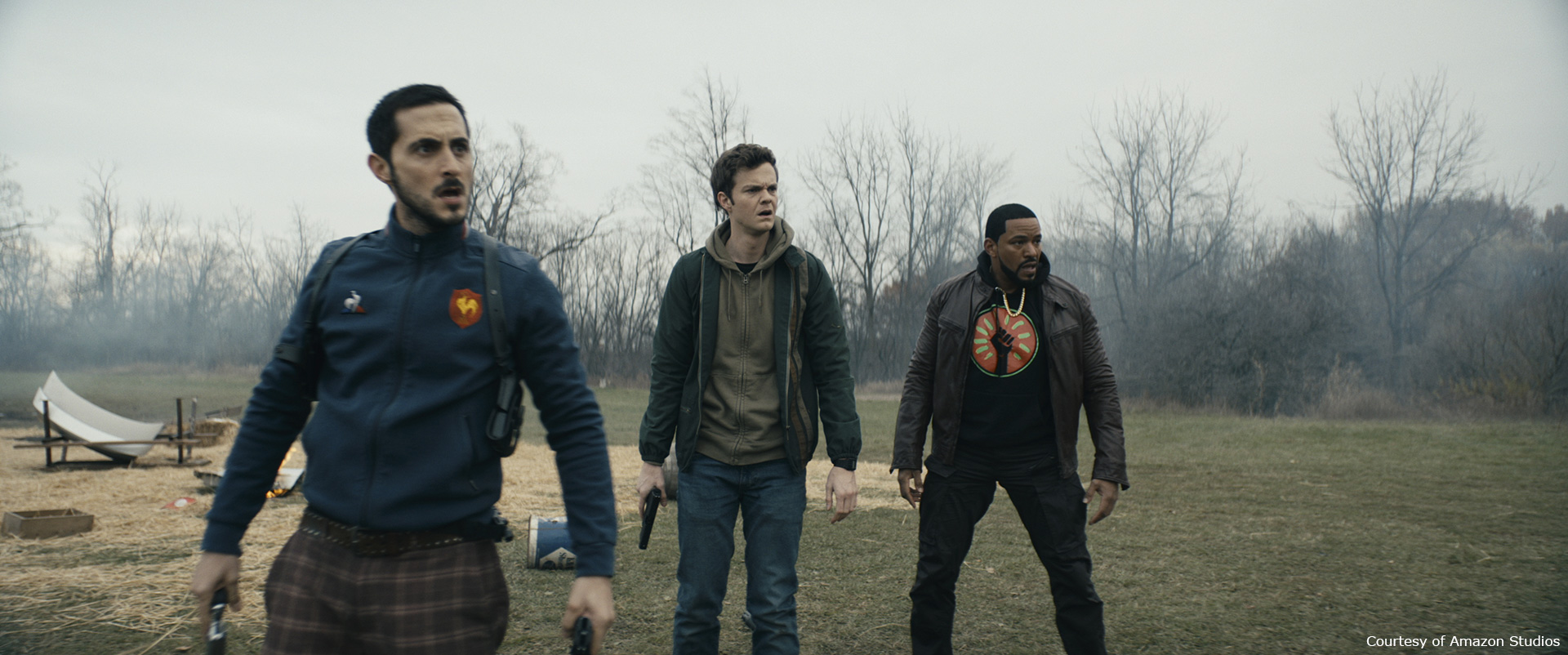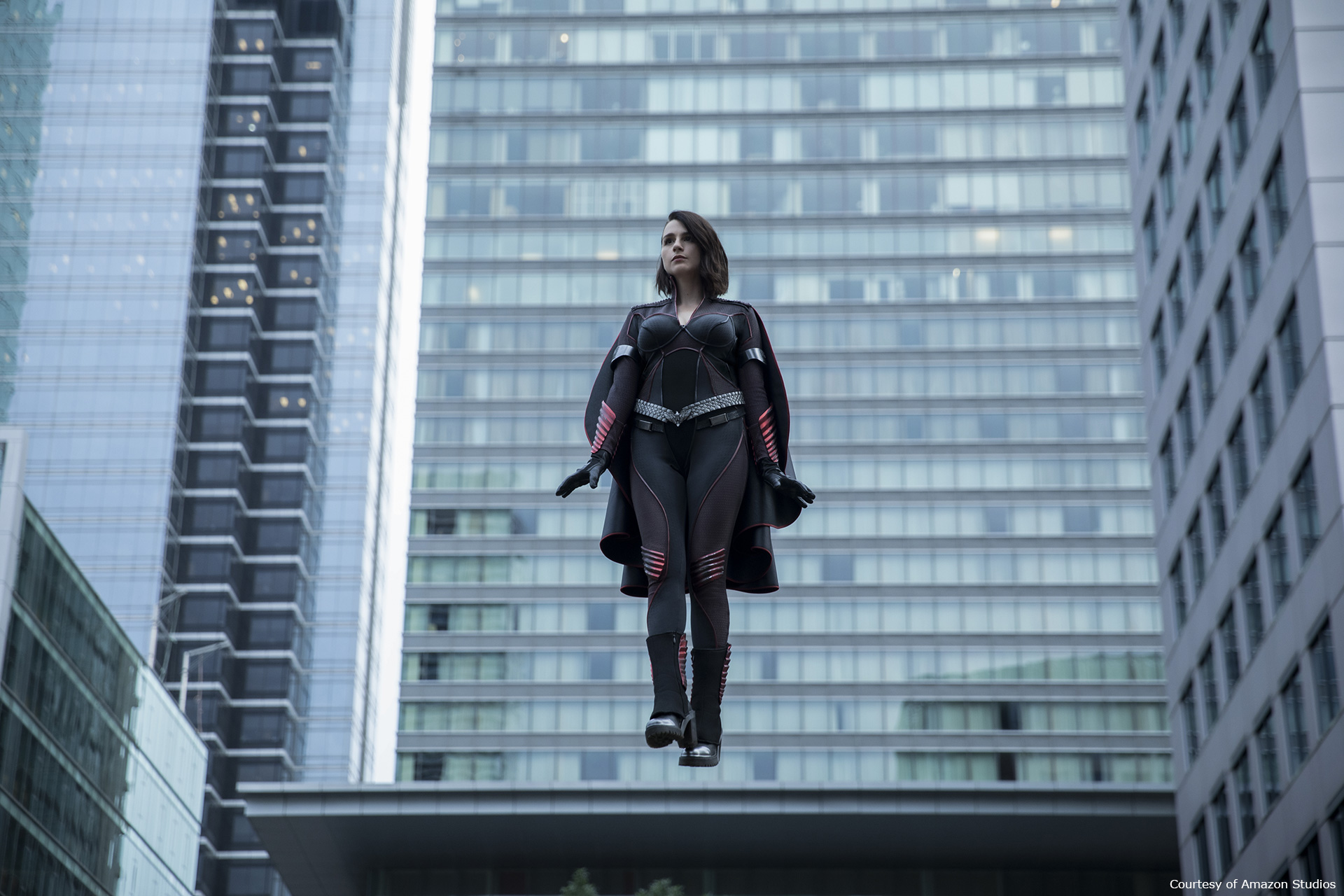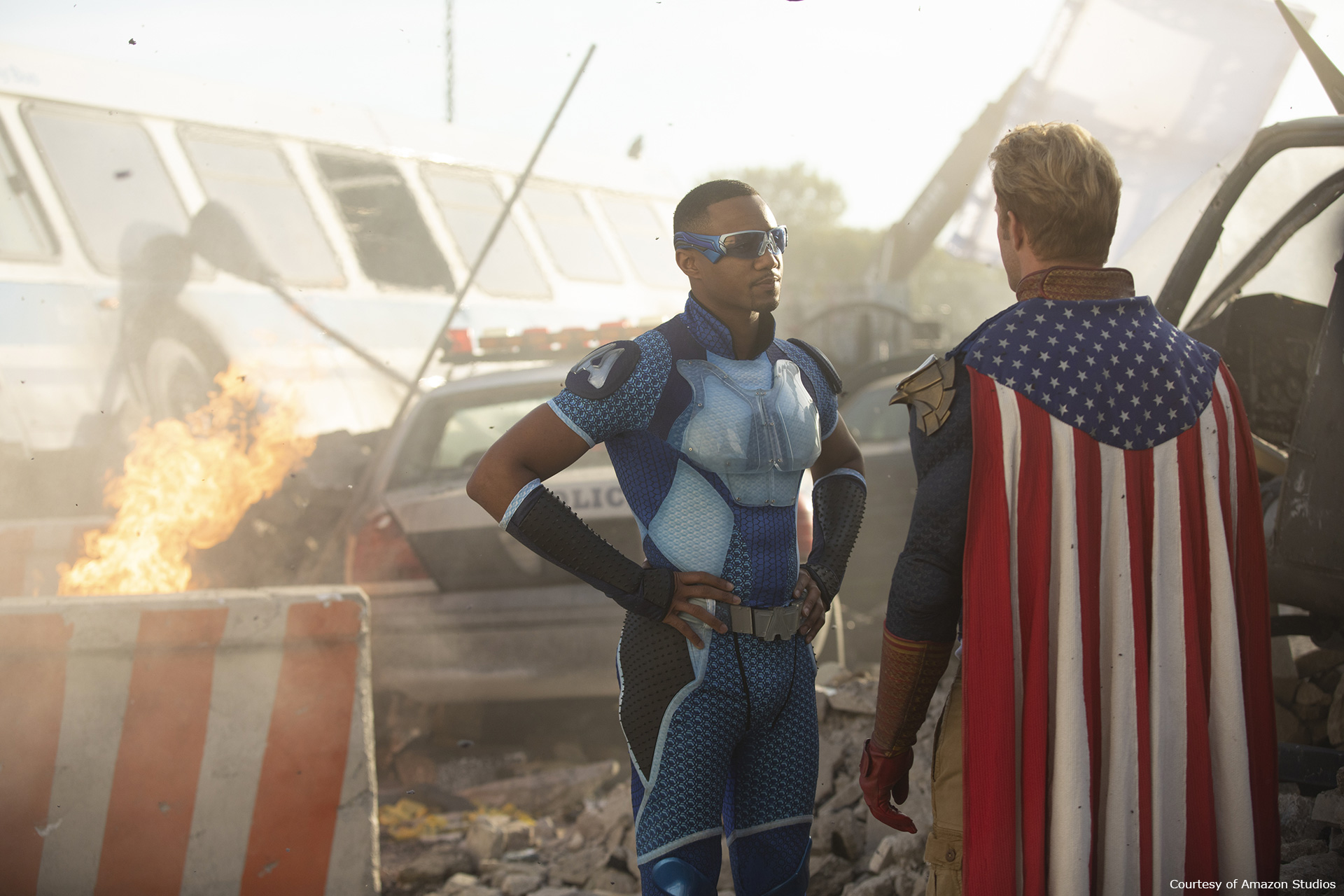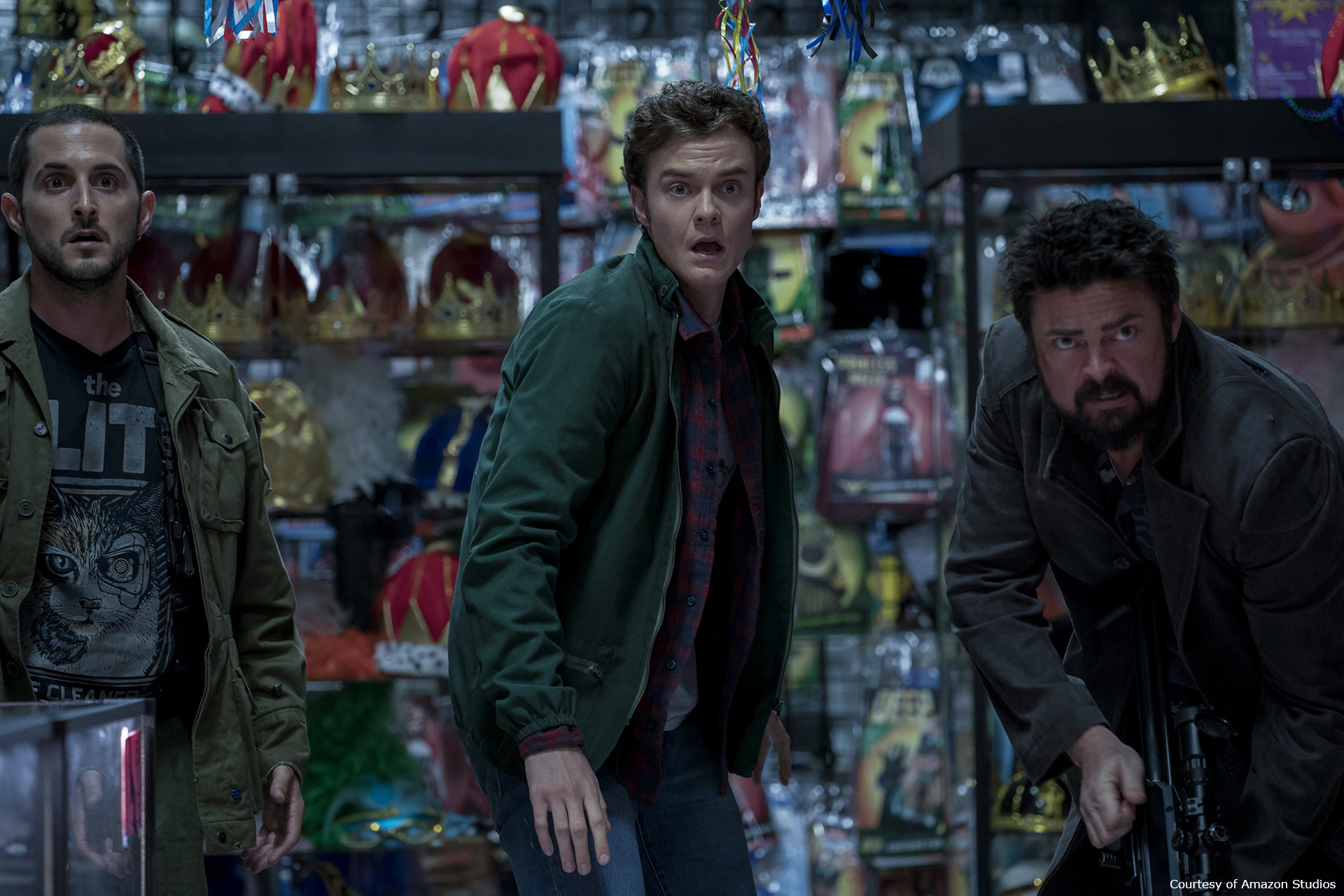Last year Stephan Fleet explained to us in detail his work on the first season of THE BOYS. He is back today to tell us about the new season and its challenges.
What was your feeling to be back for this new season?
I was really pumped. I knew I was coming back to some crazy, even bigger opportunities than season 1. Also really excited to work with my friends in Toronto and my really great VFX staff (both in LA and Toronto). I also knew I had a whale to kill, so there’s that!
How was this new collaboration with Showrunner Eric Kripke and the various directors?
It’s always great working with Eric. Our relationship has grown over the years to a point where we get each others sensibilities. Coming in to season 2 it felt like I had earned his trust. He gives me a lot of creative voice on the project, which is just awesome. We also managed to get half of the VFX done during COVID, remotely, which was unique but also worked quite well.
As for directors. I love them and aspire to direct myself. So I feel like I always have a lot in common with them. The challenge with a TV style project is that we have up to 8 unique directors coming in and out at different times, so you have to build a connection very fast. Every director is different, so your social approach changes. It can feel very jarring at times. But that’s more of an institutional, structural issue. The director’s on The Boys have all been super rad!
What are the main changes that you did from the first season?
Bigger staff in post. We double our coordinators and VFX editors. We shuffled some vendors around and had less vendors overall, but with a bit more time… and then a LOT more time due to COVID, lol.
I think emotionally, I had grown as well. Having gone through a season already, I knew more of what to expect. Not just in production, but also in post. So I think I was able to steer production to dodge issues in post that we had during season 1. I also panicked a little less. But don’t worry, I still panicked 😉
How did you organize the work with your VFX Producer?
I always consider the VFX Producer a true partner. That’s the way it has to be. For season 2, Shalena Oxley-Butler was VFX Producer and we got along really well. We have certain complimentary skills (I’m more an introvert, she is an extrovert) that we would employ wisely.
On a technical level, she handled all the finances for the show, while I was in charge of creative. Since I was in Toronto for all of production, and she remained in LA, she was in charge of the LA office, coordinators, and VFX editors as well. While I had an assistant and my full time, On-Set Supervisor Rian McNamara up north. We would also bring in some swing data wranglers from time to time from various local vendors.
To be honest, lines blur a lot and mostly Shalena and I were a pair that just did a lot of problem solving together about how to get the show done in the best possible ways.
This new season brings a new character, Stormfront. Can you explain in detail about your work on her?
Sure, Rising Sun Pictures, in Australia, handled all of her powers from beginning to end. We started very early with some concept work because we knew we needed something to show the actress and cast and crew, so gestures and stunts and such could be built around her powers. Even the scripts changed over time to match the powers we creative. Specifically, the fact that she can not only electrocute someone, but that she can grab them with her “plasma” and throw them. That became kind of a signature move that was built off of a very specific previs Rising Sun Made.
Can you tell us more about the lightning creation and animations?
It actually changed a lot from production to post. The previs I mentioned up above had a more lasso-y feel to it, smoother curves. In post, we did a ton of research on Tesla plasma. Though I know everyone says “lightning” technically we went off of the look of charged plasma in a Tesla ball (you know those things you could get in the 80s at Spencer’s gifts, and put your hands on!).
We also looked at a lot of slow motion lightning examples, and even some crazy Tesla guns people have made online, we really looked at not just the properties of the plasma itself, but the way it interacts with the camera lens and on various objects. That led us to add a little bit of secondary sparking at times, and, my favorite, this little flare out in the camera lens when she turns off her powers.
How did you improve the way you create the powers of the Seven especially Homelander and Starlight?
I’m not sure if we did much improvement here. We spent a lot of time researching and developing these looks in season 1, and the idea was why mess with a good thing? We did find new and interesting ways for them to use their powers. But technically I think they are pretty on par!
Did you use procedural tools for the eye laser effects of Homelander?
You would have to check with the various vendors that have done his eye effect. For season 2 I would talk to Rocket Science VFX and/or Soho VFX.
In a sequence, Deep is using a whale and sharks to stop the Boys. How did you create those animals and especially the whale?
Oh man I just love talking about this scene. Isn’t it just the most absurd thing ever? It started with the production designer, Arv Greywall, and his team hard at work building the practical set. It was both an exterior on the beach and an interior “gut” location, with some animatronic movement to the tail and jaw as well. Meanwhile, VFX piggybacked off of the “practical” whale set designs to start building assets and previs.
We managed to get our good friends at The Third Floor to work with the director of that episode, Steve Boyum on a complete and flushed out previs of the whole sequence. That previs became kind of the bible for how to film the scene and finish it up in post. The entire scene has only one blue screen element, which is the piece of The Deep composited on top of the whale for his big introductory shot. The rest is a blend of all real plates filmed from a helicopter or boat and heavy CG work.
We knew it was one of our biggest sequences to date so we turned to ILM London to do that whole sequence, including the shark fins. From there, it was a very procedural several months of reviewing animation passes, model and texture passes, lighting etc… I’m sure ILM has the more nitty gritty details about how exactly they went about designing the sequence… from my end, it all went very smoothly – thanks, I think, to having a really strong up front vision.
Can you tell us more about the terrible death of the whale?
Terribly hilarious, maybe! 🙂
Yeah, this was our blend point from CG whale to real whale, right when the boat hits and everything gets all close and crazy. We did add some enhanced CG organs and blood, however a lot of what you see flying at the cast is real and shot from blood and guts cannons. I also got to learn what real whale guts look like, that’s another thing I can add to my resume.
Seriously though, we had that previs, and we went back and forth about logistics. How far out does the whale have to be to get beached, what would realistically happen if a speed boat hit it. The answers were all – this would never really happen, the boat would shatter, etc… but as we started animating the previs, the concept of that great slid once the boat came to be, and it looked great and it “felt” real in the moment… so that’s how we crafted this insane sequence that’s definitely more Romance than Reality.
The season is full of exploding heads. What kind of references and influences did you receive?
So what really happened here is – yes, we did the usual thing and looked up tons of explosion reference online. We also had our good friends in Special Effects do a practical explosion in the first episode as reference…. but really, we spent a lot of time with Rocket Science on that first head explosion. Our business plan was to really spend the time and nail it on that first one, keeping all of the R&D handy, knowing there was quite a bit more of it coming down the pipe.
It became a lot of trial and error, trying different things out. More chunky, less chunky. Rocket Science developed this genius, comedic arterial squirt that comes out of the neck after the explosion, and so on.
Once the later episode hit, our investment payed off. We knew what we wanted and Rocket Science crushed it. A lot of morbid laughter during reviews!
Can you elaborates about the creation of this gory effect?
If you look closely, there are a few hero elements. It starts 1 to 2 frames of the face being broken through, then you get this medium velocity blood spray, with some gloppy chunks built in. dialing in the volume via specularity was always a thing, it worked better in some angles than others. Also, having a sub-surface scattering, semi-translucent back light kinda feel to the blood really worked if it flew up in front of a bright object.
After that, we have the neck that remains with what we called a “meat necklace.” We put a lot of time in to really seeing that flappy ripped up inside of the face and head. Then you get the blood drips down the body and that arterial squirt we love so much out of the neck.
We kinda took all these elements and, like any good VFX shot, composed them to the tempo of each moment. In this sense, VFX is a lot like music, there is a cadence and a tempo to how fast and slow things happen. The rate at which the body falls after, when to cut out of the shot, etc.
I also, personally, prevised the crap out of that courtroom scene. What felt great about that one is that the director and I really were able to collaborate in production and get a lot of great looking, pre-designed stuff. There was also plenty of room for improv however. One of my favorite, on the fly supervising moments was this shot of someone running away from camera whose head explodes in the FG. We shot it hand held and got some really quick camera tiling afterwards. It was one of those things, earlier in my career, that would have worried me… but I was able to take a look at some recorded rehearsals and with a few minor adjustments, make a very shoot-from-the-hip style shot very doable in VFX. I think the shot came out great and has that earthy, “grounded” vibe we all wanted. Everyone wants grounded these days. Heh.
How did you work with the makeup and SFX teams for this effect?
The Kenny Family, Tony and his sons JR and Hudson, do all the SPFX for the show – and they rock. I mean, when they say they are gonna blow something up. They blow it up. We have a very health working relationship together, often sharing notes and concepts. Since the show really is about trying to keep things ‘real’ we rely on SPFX a lot!
Even the very last day of production, we had a bit of a set emergency where we needed to craft a fake puppet head for Homelander to grab on to. We went in to their shop and dug around and after about an hour we had built something together as a team. And that’s the way it should me.
Make Up Fx is one of the hardest roles on this show. It also has me on the edge of my seat. A lot of the human gory-effects are attempted practically. And basically, the more it works out on set, he better for VFX. If it doesn’t work… well… post production time, baby! Therefore, it was in my best interest to work closely with Make Up Effects as well.
During a fight with Stormfront, a whole pack of building are destroyed. How did you handle those destructions?
This was all the work of Rising Sun Pictures. Much of the stuff inside the building was enhancement of practical debris that stunt people crashed through. Also a lot of false walls for supes to smash each other in to. Often it was a mixture of making the real stuff feel a little more solid and then adding some more CG on top.
We had prevised that big shot climbing up the building, and then RSP did this wonderful post-vis that got us the timing we needed for editorial. From there it was a lot of procedural iterations to get all the components to not only look photo-real, but tell the story of what’s going on as we ascend the building.
How did you enhance the Seven Tower model and the city environment?
A few vendors tackled the 7 Tower in season 2. Primarily Ollin VFX and Rising Sun Pictures. We had a pretty good idea of what we wanted coming out of season 1. We found that we really like inserting it in to aerial footage of NYC. In fact, as post went on and on for season 2, what Eric and I realized is that some of the best effects for this show are the “throwaway” effects. That is, something in VFX that adds to a frame, but doesn’t really call attention to itself. So expect more of that in the future!
Can you tell us more about the crowd creation and animations?
In season 1 Rocket Science VFX in Toronto stepped in and did the crowds for the Believe Festival. They did an amazing job. So we had them come back and rock out the crowds in season 2. We knew there was at least one challenging scene that would require a lot of digital doubles, so we started that early.
Our rule of thumb on the show is that if we are in a medium to close shot, it has to be real people. If it’s really far way, we find clever ways to make digi-doubles work.
The concept of crowds is really important to the world of THE BOYS. We do a lot more practical crowd work than others do these days. I’m that guy always fighting to hire more background talent! I don’t know, I just feel like doing crowd duplication really constricts your camera movement and forces you in to green screen scenarios that I am not a fan of. Kind of like driving comps, I can always tell. So I’m pretty against excessive crowd replication.
Where was filmed the various parts of the series?
The show is filmed entirely in and around Toronto, Canada.
Did you bring new vendors on this season?
Yes! Rising Sun Pictures, ILM, and Ollin were new this season!
How did you split the work amongst these vendors?
The best answer is that we split it out on a case by case basis, always keeping in mind what challenges shuffling things around will pose to our vendors.
Can you tell us more about your collaboration with their VFX Supervisors?
I mean, the vendor VFX Supervisors are really the keys to all the doors of a project. Without their creative input and leadership, everything would fall flat. I do my best to come up with clear visions of what we want… but to be honest, that doesn’t always happen. I’d say 50% of the time it’s an exploration, and I need a strong creative partner for that exploration. Also, while I’m busy focused on 1000 things delivering at the same time, the idea of breaking something up is to give facilities smaller chunks to focus on and ultimately make better..
Just like, well, about any relationship in life – sometimes things just work great. But most of the time communicating is hard work. It’s something I’m very reflective about. I’m constantly on the search for how I can communicate better.
That being said, all the VFX supes I worked with on S2 were super cool and brought a lot to the table. I recently looked at IMDb and realized there were 330 VFX credits alone! That should give you some idea of just how many people are integral in making this show a reality. And just how many people all the vendor-side supes are responsible for creatively leading. It’s amazing and humbling.
Which sequence or shot was the most challenging?
Can I just say all of episode 206? hah!
Seriously, the challenge with that episode, and I knew it from the start, is that it is all unique IP. By that I mean it had a bunch of unique super heroes with unique talents… but that you only see one or two times. So we had to R&D and come up with a season’s worth of powers and gags for just one episode.
On a side note, I 2nd Unit directed all of the supes you see in the monitors. It was all filmed in real cells in an abandoned psych institute, so that was super creepy and cool
Did you want to reveal any other invisible effects?
Haha, a magician never shows you their tricks 🙂 But let’s just say Jack Quaid isn’t actually real, he’s an AI we made in a computer.
Also superhero capes are a big thing. Whenever they fly, they need to be rigged on wired harnesses, and the capes get in the way. So if you ever see someone like Homelander or Stormfront hovering, their cape is CG.
Also a lot of CG blood and wounds. A lot.
What is your favorite shot or sequence?
That’s a tough one this season. The Whale is definitely up there. Honestly, I like the whole second half of episode 3, it’s mostly action and VFX for a solid 20 minutes.
Weirdly, I would say one of my favorite shots is in the second episode where Kenji tosses Kimiko in to that building. It was a great example of a real to CG blend that I just felt came off looking really real.
There’s one shot, later on, where Homelander and Stormfront take off from Becca’s back yard with Ryan and we tilt up to follow them. I really liked the tempo of that shot. it’s one of the few times where they don’t just rocket away, we get to see them hanging out up there.. but the CG passed the bar because it was night and a severe up angle.
What is your best memory on this show?
There are a lot of great ones and a lot of great people I’ve worked with and gladly call friends. I think my favorite memory though, was getting to sit in on a cast screening of the first three episodes of season 1. At that time, they had never seen the show with completed VFX… also, no one knew if the show was gonna be a hit or not. So there was a lot of, just, excitement in watching our cast lose their shit watching the show. It was really great.
How long have you worked on this show?
Since the very beginning! Sometime early/mid 2018.
What’s the VFX shots count?
I think we had around 1200 shots in S2. but I will say that the per-shot complexity and size grew by about x3 over S1.
What was the size of your team?
Pretty small. 3 of us in Toronto, 6 in total in LA. Looking to grow that a bit in the future!
What is your next project?
I’m returning for S3 of THE BOYS.
I was bumped to Associate Producer at the end of S2, so excited for the new opportunities ahead!
A big thanks for your time.
WANT TO KNOW MORE?
Rocket Science VFX: Dedicated page about THE BOYS on Rocket Science VFX website.
© Vincent Frei – The Art of VFX – 2020













